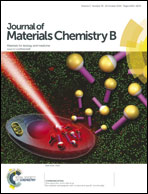Silk nanofiber hydrogels with tunable modulus to regulate nerve stem cell fate†
Abstract
Reconstruction of damaged nerves remains a significant unmet challenge in clinical medicine. To foster improvements, the control of neural stem cell (NSC) behaviors, including migration, proliferation and differentiation, is a critical factor to consider. Topographical and mechanical stimulations based on the control of biomaterial features are promising approaches, which are usually studied separately. The synergy between topography and mechanical rigidity could offer new insights into the control of neural cell fate if they could be utilized concurrently in studies. To achieve this need, silk fibroin self-assembled nanofibers with a beta-sheet-enriched structure are formed into hydrogels. Stiffness is tuned using different annealing processes to enable mechanical control without impacting the nanofiber topography. Compared with nonannealed nanofibers, NSCs on methanol annealed nanofibers with stiffness similar to that of nerve tissues differentiate into neurons with the restraint of glial differentiation, without the influence of specific differentiation biochemical factors. These results demonstrate that combining topographic and mechanical cues provides the control of nerve cell behaviors, with potential for neurogenerative repair strategies.


 Please wait while we load your content...
Please wait while we load your content...